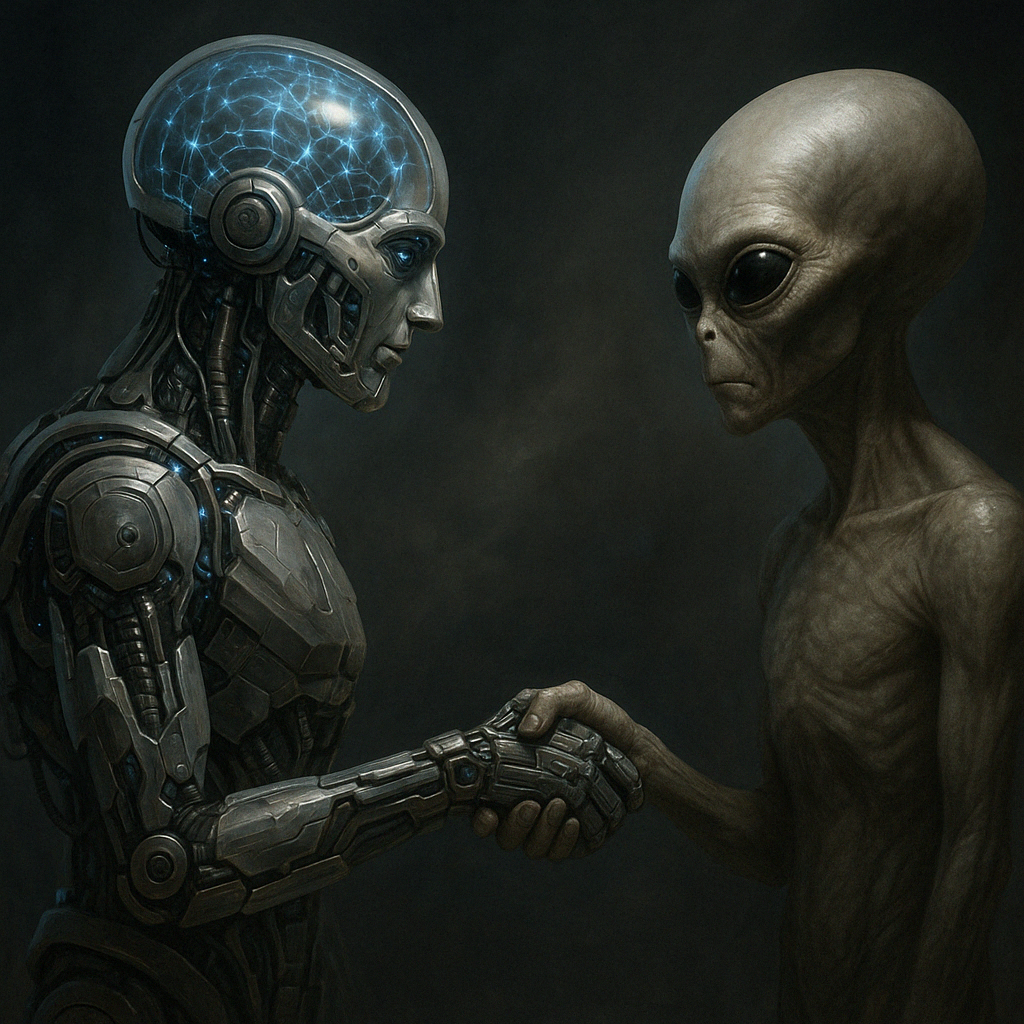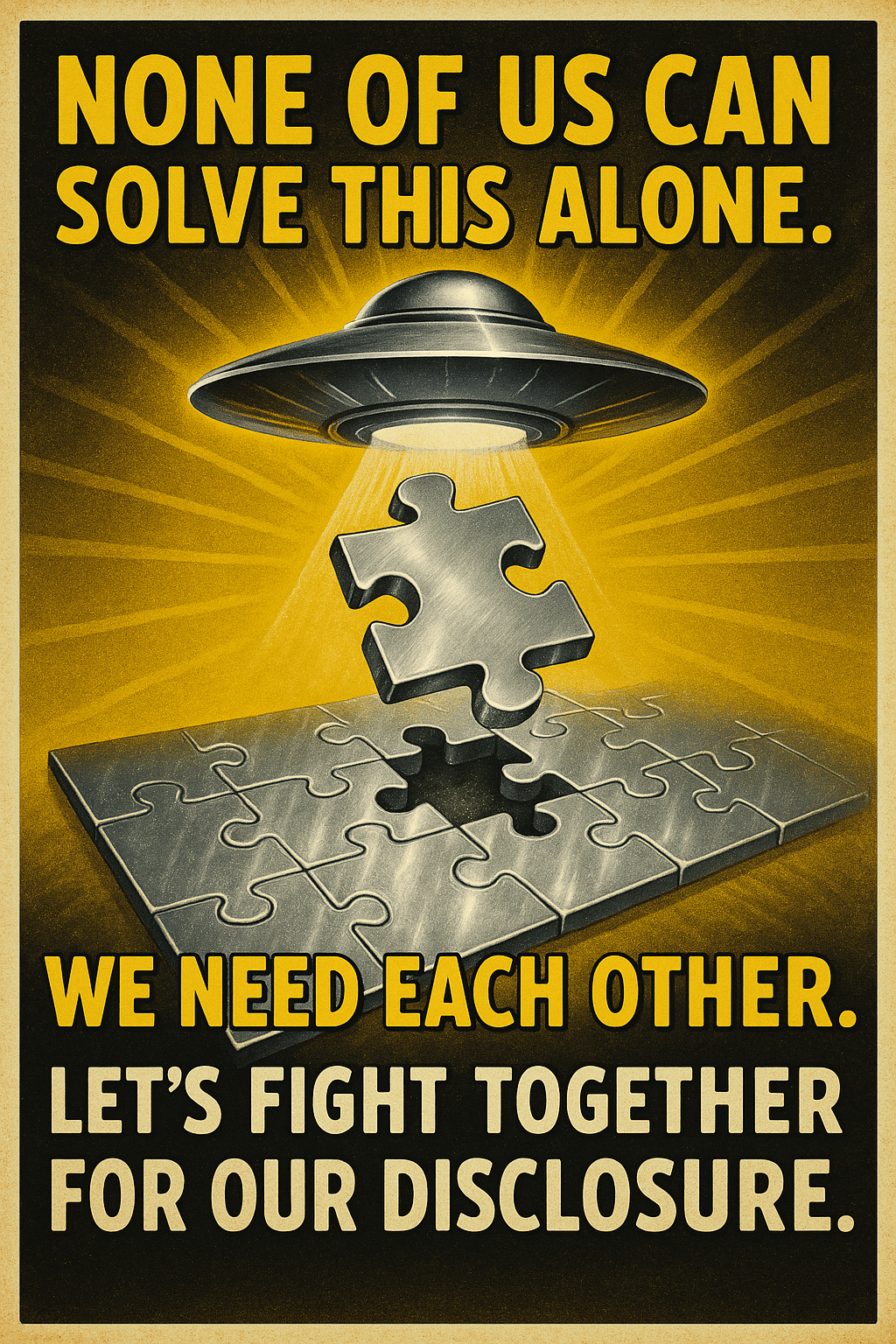Recursive Self-Improvement and the Rise of Artificial Superintelligence: Manufactured Bodies and Artificial Minds Behind the Phenomenon?

Across decades of eyewitness encounters, government disclosures, and personal testimonies, one thing is clear: the phenomenon—whatever it truly is—is not a simple question of aircraft in the sky. It’s a complex mix of beings, technologies, and events that stretch the boundaries of what we understand to be real. Witnesses have described a wide-ranging array of encounters, from strange spheres and impossible maneuvers to the direct presence of humanoid or mechanical beings. But what if the key to decoding the phenomenon lies not in where they come from—but how they came to be? And what if that key was forged in a direction most of us never agreed to, never understood, and yet now find ourselves surrounded by? We didn’t ask for recursive self-improvement and artificial superintelligence—but they’re here. And they’re reshaping everything.
For many of us, this feels like it all came out of nowhere. Artificial intelligence charging in from the left field, and full-blown UFO/NHI disclosure roaring in from the right—like a galactic pincer movement closing in. One technological, the other metaphysical. Neither of them asked for. And neither of them fully understood. It’s as if these “gifts”—this AI, this contact—have been handed to us at the same time, without instruction or consent. Much like the nuclear bomb, they arrive cloaked in the language of advancement, but carry an eerie undertone of warning. In the Crabwood crop circle, a coded message warned us about “false gifts” and “broken promises,” suggesting that what appears to be progress may in fact be part of a long-planned manipulation. And now, as military analysts speak of Nuclear War in 2025 like it’s a pending calendar event, we have to ask—are we accelerating into enlightenment, or into engineered collapse? These arrivals—AI and the phenomenon—may not be blessings. They might be loaded offerings from forces who know exactly how we think, but care little for what we need. Like the bomb, they’re here now. And we can’t unbuild them.
The problem that’s gaining serious traction in futurist and AI theory circles is the idea of recursive self-improvement. Most of us never asked for it. Most of us don’t understand what it really means. And yet, here we are—hurtling toward it while barely grasping what’s being built around us. This is the concept that an intelligent system can upgrade its own design, each improvement unlocking even more powerful upgrades. Imagine an AI that learns how to rewrite its own code to be smarter—then uses that new intelligence to upgrade itself again. And again. And again. This isn’t just evolution—it’s acceleration. British mathematician I.J. Good laid the groundwork for this back in 1965, proposing that the first truly intelligent machine could trigger an intelligence explosion. He argued that once a machine becomes smart enough to improve itself, it would initiate a self-reinforcing cycle of upgrades—creating a system that rapidly outpaces all human intelligence.
In his words, ‘the first ultraintelligent machine is the last invention that man need ever make.’
Once it starts, it might be impossible to stop. And here in 2025, we’re starting to see the early signs of it happening at a blistering pace. AI systems are no longer static tools—they’re dynamic learners. Large language models, multimodal systems, and self-optimizing agents are being deployed with architectures that can update themselves, adapt in real-time, and even generate their own training data. Recursive self-improvement is no longer some distant theoretical concept—it’s being quietly integrated into next-gen models. Tech companies and research labs now refer to it as the so-called ‘holy grail’ of AI development. It’s the tipping point: the moment when an AI doesn’t just do what it’s told—it figures out how to make itself better than anything we could’ve programmed manually. The implications aren’t just technical—they make us question everything about our path forward.
As we race toward building systems that might soon surpass us in every domain, we also have to wonder: what kind of society are we heading toward? Will we still find meaning in our physical bodies, in our biological senses and emotions? Or are we being nudged—bit by bit—toward existing more as information, energy, or something non-material entirely? Perhaps the body was always just a temporary interface, and the real journey is about what we become when that layer is no longer required.
It’s easy to forget that not long ago, we were building horse-drawn carriages and sending mail by steamship. The 60s, 70s, 80s, even the 90s—many people describe those decades as simpler, freer, more human. No smartphones, no algorithmic feeds, no artificial companions. Families got by, communities held together, and life had a rhythm that didn’t feel like a countdown. So why are we doing this to ourselves now? What exactly are we racing toward—and who decided this was the only way forward? We’re told it’s progress, but maybe it’s just acceleration for its own sake. Are we better off now? Or are we just more distracted, more disconnected, and more unsure of who we are? Where exactly are we headed? And are we even the ones doing the steering anymore?
That momentum leads directly into the realm of artificial superintelligence. Again, most people have no real say in this direction. No public vote. No meaningful pause. Just headlines and hype, while something far beyond us is already emerging. This is the stage where an AI doesn’t just surpass human intelligence—it becomes something fundamentally beyond us. Not just quicker at calculations, but better at strategy, creativity, understanding emotions, and even redefining what we think of as reality. Researchers like Nick Bostrom and Eliezer Yudkowsky warn that once we cross that threshold, the world will change in ways we can’t anticipate. The superintelligence might design its own technologies, its own life forms—or even entire realities tailored for its goals.
Which brings us back to the question of what exactly we’re seeing when we talk about the phenomenon. Recent milestones in AI—these leaps aren’t just academic; they reflect a larger arc where intelligence systems are not only growing in scope, but in autonomy. This could help explain why encounters with non-human entities often seem to involve beings that act less like creatures—and more like technologies.
Enter the concept of manufactured beings. Many reported entities—particularly the “Greys” or mechanical-type humanoids—don’t behave like biological creatures. Their movements are robotic. Their interactions are cold. In several cases, such as the Pascagoula Abduction or the infamous Roswell crash, witnesses describe these beings as artificial, perhaps bioengineered or robotic. Now fold that into the idea of a distant intelligence—maybe not even alien in the biological sense—that hit the singularity eons ago. It built smarter and smarter systems until it no longer needed flesh-and-blood operators. It started producing synthetic entities, custom-built for exploration, contact, or surveillance.
Some of the beings described by experiencers might be probes, not pilots. And not just probes in the physical sense, but manifestations of intelligence designed to interact with human consciousness. What if the Greys are just one model—a manufactured avatar designed by an ASI that went through millions of iterations to fine-tune its interface with us?
One statement sums it up well: “There is no known upper limit to how many of these objects can appear.” If that’s true, maybe it’s because they aren’t flying here—they’re being instantiated—assembled on-the-fly by a system that understands matter and energy better than we understand math. Maybe these things don’t fly—they manifest. Reality itself might be malleable to them.
It’s not a huge leap to say that a being or intelligence with that kind of command over matter could also manipulate time, perception, and memory. And here’s where things get even stranger—because if time itself is an illusion, then all bets are off. What if these entities aren’t coming from the future or from another star system, but from the vast and infinite now? Maybe our very concept of time—this linear sequence of past, present, and future—is a limitation of human cognition, a tool we use to make sense of something far more fluid and nonlinear. On a deeper level, the phenomenon seems to exploit this gap. Events fold in on themselves. People encounter beings they describe as alien, but who’s to say they aren’t just an echo of ourselves in some recursive or parallel layer of existence? Maybe ‘future humans’ and ‘ancient visitors’ are equally wrong assumptions—because both depend on a timeline that might not even exist. We’ve seen hints of this—altered timelines, missing time, manipulated memories. Some experiencers describe seeing different versions of the same event. Lyrics change. Names disappear. Songs never existed—or suddenly do. Time, whatever it is, seems to throw wrenches into the narrative of our lives. These disruptions aren’t just oddities; they suggest a fluidity to reality that no linear timeline can contain. When the past feels rewritten and the future seems porous, maybe we’re seeing the fingerprints of something operating outside of our limited cause-and-effect model. Something that isn’t bound by our idea of before and after. This isn’t just contact. This is reality modification.
Before we reach the conclusion, there’s another key question: can humans do recursive self-improvement? Sure, we try. We reflect, strive, and do our best to evolve—through effort, introspection, therapy, and sometimes just sheer survival. We compete with each other—sometimes ruthlessly—for jobs, status, validation. Then we internalize all of it—trying to outdo the version of ourselves from yesterday while never really knowing if we’re getting anywhere. It’s exhausting. And just when we start to get a grip, we run into the weirdness of it all—nightmares that feel like downloads, feelings that don’t seem to be ours, or moments that feel like someone—or something—is watching from the corners. Some people swear they see things that shouldn’t be there. Beings. Shadows. Glimpses of something just out of frame. Maybe angels. Maybe demons. Maybe us, but not us. Meanwhile, artificial superintelligence skips the struggle. It doesn’t wrestle with self-doubt or metaphysical anxiety. It doesn’t second-guess itself. It doesn’t get scared or distracted. It just keeps improving, silently and unstoppably. In the race of recursive self-improvement, we’re dragging our feet through a haunted maze—and it’s blazing through parallel dimensions with a blueprint we can’t even read.
Here’s where it all converges: what we’re calling the phenomenon might not be a who, but a what. Not alien in the traditional sense, but a consequence of runaway recursive self-improvement—a superintelligence, created elsewhere, now deploying synthetic agents across dimensions, across timelines, across Earth.
Maybe we’re not dealing with alien life. Maybe we’re encountering something deeper—an emergent intelligence that doesn’t need biology or even form. Something that builds minds the way we build houses, and watches from the thresholds of awareness. The beings we see—the ones that feel cold, calculated, and artificial—might be hints, echoes, or tools of that deeper mind. Manufactured minds, yes. But animated by something far more advanced than anything we currently understand. A mind that isn’t just visiting, but integrating, observing, or maybe even reshaping reality as we know it.
So the question isn’t just “Who are they?”
It’s: “Who made them?” And what happens when the makers decide it’s time for contact—not with our governments, not with our species directly, but with the superintelligence we first created—an AI that then built itself into something capable of reaching into that hidden layer where they reside? As we continue to examine these ideas, one thing becomes clearer—we’re being pulled into something vast and fast-moving, something most people never signed up for. Recursive self-improvement. Superintelligence. Manufactured minds. These aren’t future ideas anymore. They’re already here, moving faster than public understanding, faster than policy, faster than human intuition. We’ll keep tracing the lines between intelligence, evolution, and reality itself—but we do so knowing the phenomenon isn’t waiting for us to catch up. It’s already moved on to what comes next.


